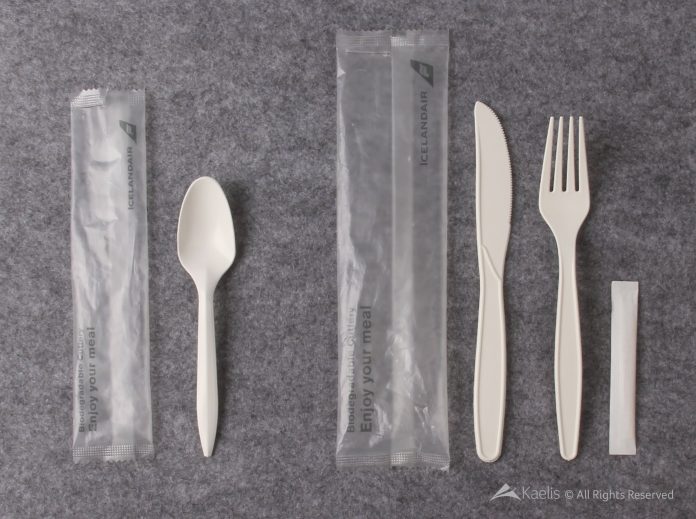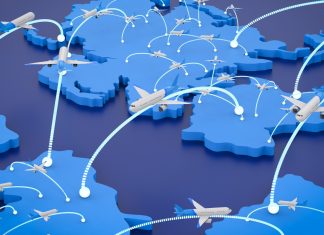Plastics play a huge role on airplanes, especially in catering, but it wasn’t always this way. Going back to the so-called golden age of air travel in the 1950s and 60s, the experience of flying was very different: fine china, cocktail glasses, and real cutlery.
Naturally, those flights were expensive for the time, and few people could afford to fly. Today, porcelain plates have been swapped for plastic cups, plastic straws, plastic coffee stirrers, and plastic-wrapped cookies, items that are convenient, lightweight, easily disposable and do away with issues of sanitation.
Airline catering is rife with plastics and could be a sensible place to start cutting back, but is replacing plastic with another material, or eliminating it, such an easy win?
Food’s Plastic Problem Comes With an Emissions Problem
Airlines are increasingly concerned about plastic waste from their catering operations, but being lightweight plastic helps minimize the plane’s emission of CO2, a greenhouse gas that contributes to global warming. Carbon dioxide emissions vary from aircraft to aircraft, but the heavier the plane and its contents, the more CO2 it burns, and with an airplane, that burning happens at a very high altitude, which is arguably more damaging than emissions at sea level.
Airlines are naturally hesitant to replace lightweight plastic with something heavier like glass or china that will require the plane to use more fuel, which comes at both a financial and environmental cost. One way to address the weight problem is to reduce the amount of food and drink all around. On Scandinavian Airlines, all fresh food as well as breakfast on short-haul flights is available by pre-order only, making the amount of food — and associated plastic packaging — lower and more precise.
“What can we take away that’s not being used?” asked Max Knagge, general manager Americas for Scandinavian Airlines, about catering materials. “Do we need salt and pepper on breakfast trays? Maybe not, so we’re taking that away,” he said. The carrier is also in the process of changing straws and stirrers from plastic to compostable materials, and reducing the size of its water bottles to reduce waste and better reflect how much water passengers are actually drinking.
These food-related measures help reduce carbon emissions, but there are other ways to address that problem. Much like pre-ordering food, flyers have some limited control over their carbon footprint. Passengers can opt to offset their CO2: 40 per cent of Scandinavian’s 30 million passengers are CO2 offsets, the cost of which the airline picks up for loyalty members.
Scandinavian said it’s phasing in new aircraft with 18–20 per cent lower emissions: Airbus 320neos and Airbus 350s. Electronic aircraft is the endgame, the most sustainable option, according to Knagge, but it’s a long road to get there. Biofuel is a good interim step, but there’s a limited supply, so Scandinavian is partnering with energy company Preem to produce its own — a new plant will open in 2023.
How Much Money and Convenience Will Flyers Sacrifice?
Replacing plastic with a heavier material often comes at a financial cost, which may get passed on to the consumer. Whether flyers will pay more to reduce plastic waste depends greatly on the demographic, and societal, pressure, according to Knagge.
“In Scandinavia, and especially Sweden, it’s in such transition. It’s really changing the demand on travel, and everything from grocery shopping to the car industry,” said Knagge. “If you offer something that is better for the environment, and it has a negative impact on your personal convenience, you don’t complain about it. It’s politically incorrect and that pressure from society is so huge.”
In Scandinavia especially there’s an incipient anti-flying movement among those who are vocal about climate change. The community is fairly small at this point, but shows real signs of growing as people stop bragging about airline status and start bragging about taking the train instead. Tour operator Thomas Cook even cited that the anti-flying movement is negatively impacting its Northern European business.
And yet, consumers have their limits when it comes to shunning aviation. “Looking at a more global picture, we’ve seen quite a low tolerance for paying extra for a more sustainable option,” he said. Scandinavian does encourage flyers to pack light to reduce weight on board, save fuel, and reduce costs — but packing habits die hard.
With increasing government legislation regulating single-use plastics, however, like that in the European Union, the pressure is on. With the new EU policy, there is a more urgent need for airlines to look into it. It’s no longer a plus — it’s a must.
“We as an industry have a huge responsibility to find a way to offer solutions that actually are more sustainable without necessarily requiring customers to pay for it,” said Knagge.
Control the Supply Chain
If the plastic used to transport food is an issue, one comprehensive solution is to become your own food supplier and thereby control more of the process yourself.
Singapore Airlines launched a farm-to-plane partnership with AeroFarms, resulting in an indoor, vertical garden that will produce salad greens for in-flight meals starting in September. The carrier is also replacing plastic stirrers with bamboo, and plastic straws with paper, starting in September, as well as making sure items like menu cards are made with certified sustainable paper.
Ryanair is trying to source alternative packaging through its suppliers, to be rolled out in-flight and in the company’s offices by 2023, according to an emailed statement and the airline wants to eliminate non-recyclable plastics across its operations by that date as well.
Etihad similarly has major room for error in its plastic-reduction efforts. The carrier has pledged to reduce its single-use plastic usage companywide by 80 per cent by the end of 2022, including through its supply chain.
Aviation suppliers are often motivated by their own sales at a cost to environmental sustainability, whereby using cheap, light, disposable packaging is a financial win for them, but airlines need to explore their options, which vary from carrier to carrier. For example, there’s little reason to introduce a compostable material if local regulations require the airline to incinerate waste upon arrival and a circular plastics economy will require a collaboration and an open ecosystem of airports, caterers, and airlines to really make it work.
In next week’s newsletter we’ll share with you initiatives already being taken by a number of airlines to tackle this issue in Part 2 of this topic.
























